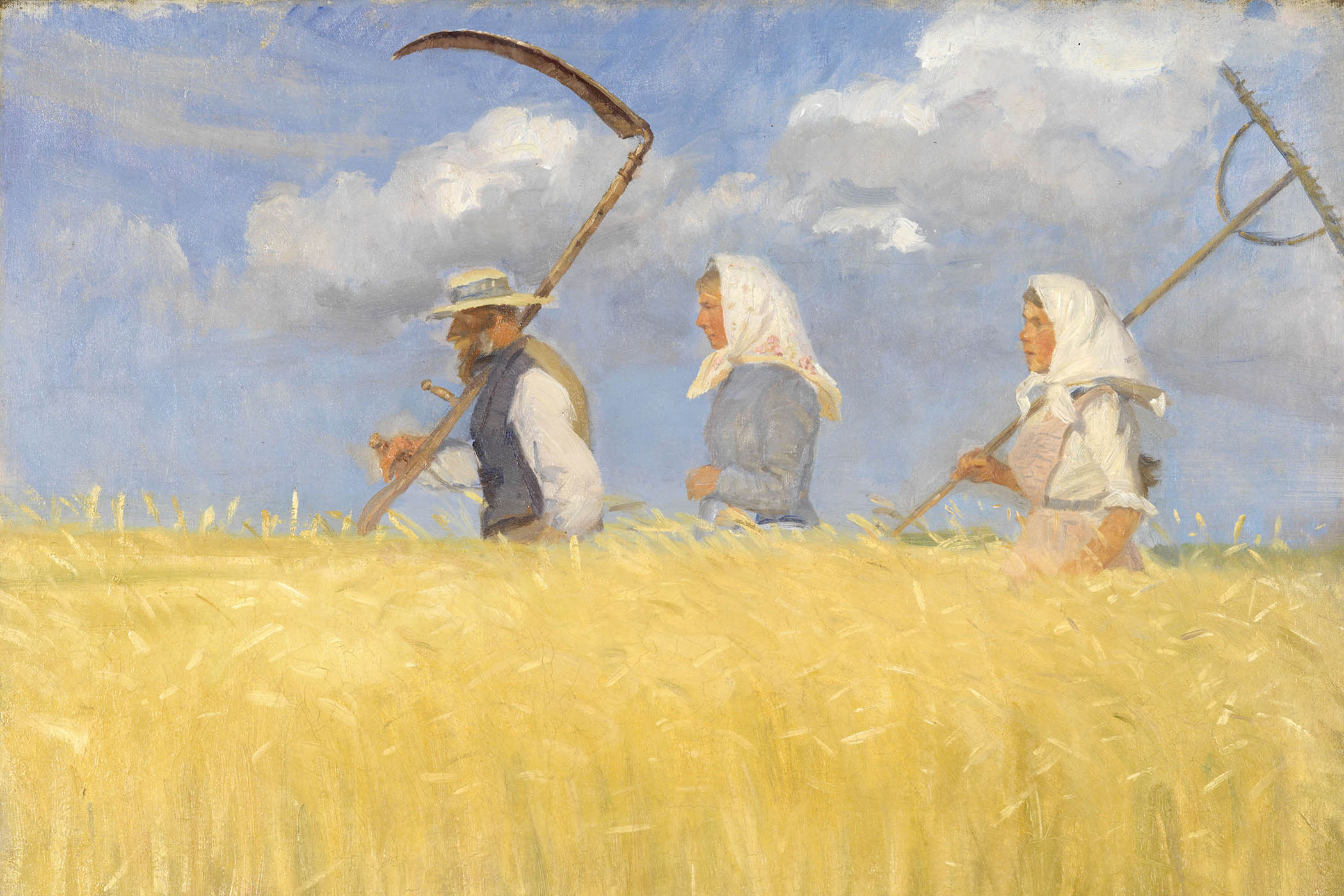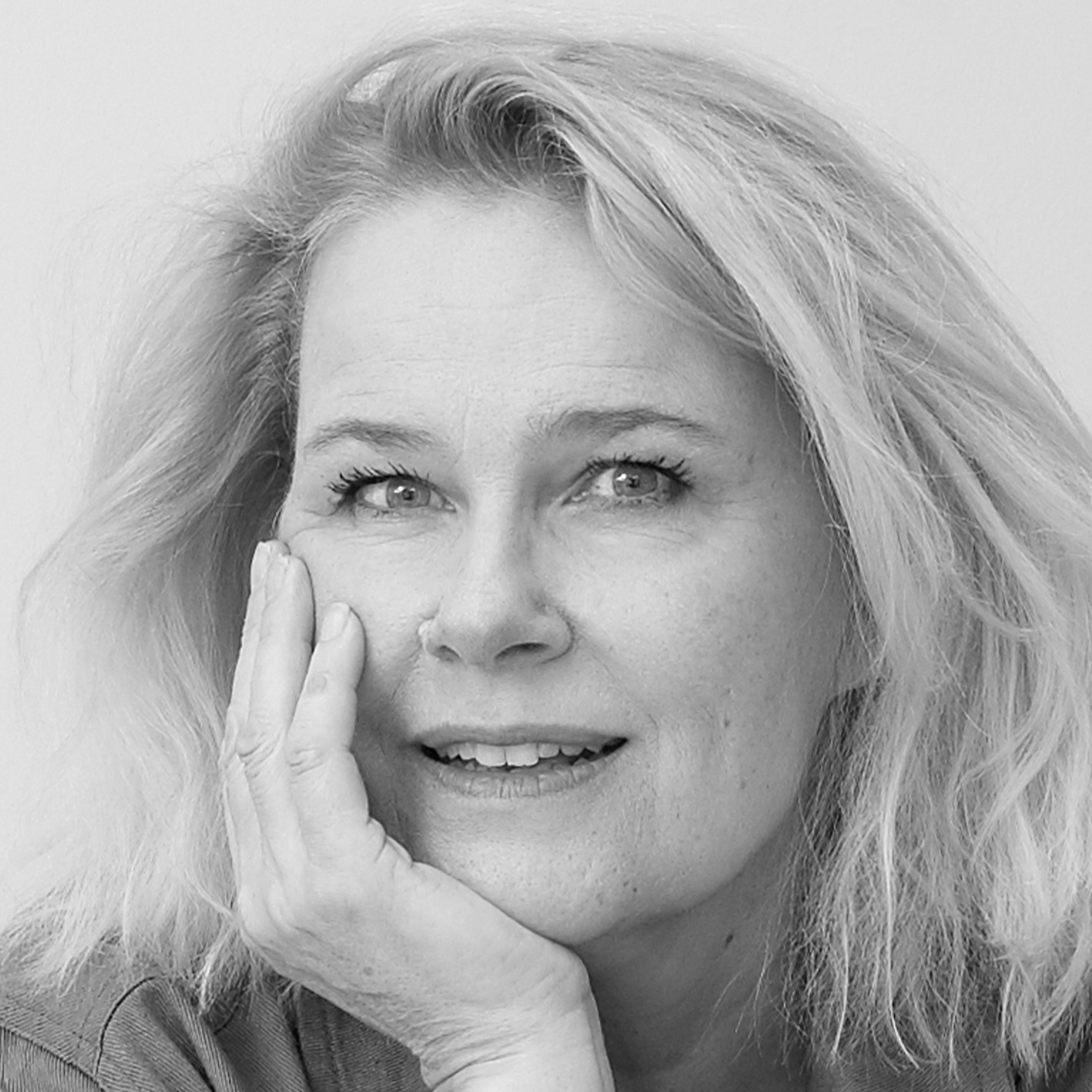Two seas meet at the furthest tip of Jutland in northernmost Denmark. They meet but they do not mingle. This phenomenon is so strange that visitors can’t help going to see whether it can really be true, following the coastline to Grenen, as it is known, where the sands narrow to a vanishing point between the two tides.
The sky shimmered, high and blue on the October day I visited. You follow the dwindling spit of sand as far as you dare, out between the Skagerrak and Kattegat seas – part of the North Sea and Baltic Sea respectively – constantly meeting and parting like two sides of a dance. Today, the waters are shallow and calm, purling away from each other in mesmerising motion, one slightly wilder than the other. But winter brings ferocious turbulence. Many sailors have drowned here.
You walk to Grenen, almost two miles (about 3km) from the little town of Skagen, along a soft white beach where the night barely darkens in summer. So many paintings exist of this strand, by the famous colony of Skagen artists, that the art museum is filled with visions of figures on the sand. The most beloved, by Peder Severin Krøyer, shows two women in white dresses strolling along the beach at twilight in 1893, the waters serene and luminescent, the late rays gilding their sashes.
One of the women is Krøyer’s wife, Marie, arm in arm with her friend Anna Ancher. Marie is talking, Anna is listening; both women are painters. Marie will depart for Sweden, but Anna remains here by the sea. To visit Skagen is to see Anna’s face everywhere, in portraits, group paintings and photographs, in posters and postcards, museums and shops, always watchful and silent. With her long profile, large clear eyes and distinctive nose (its bridge broken in childhood, hair caught in a smooth bun at her nape), Ancher is immediately recognisable; at least, in other people’s art. She never appears in any of her own works. The only exception is a diffident self-portrait made about the age of 16, in which she gazes obliquely at herself in the mirror. Even in photographs, she scarcely looks us in the eye.
This self-portrait will be greeting visitors at the entrance to Dulwich Picture Gallery’s much anticipated Anna Ancher: Painting Light. It is the first survey of her art ever mounted in Britain. With more than 40 works, from early scenes of Skagen when it was still a village, to the better-known images of women reading, sewing, knitting, dreaming, heads bent over their work in the ever-changing light, to the paintings that border on abstraction in their celebration of that light, the show will be a revelation.
Related articles:
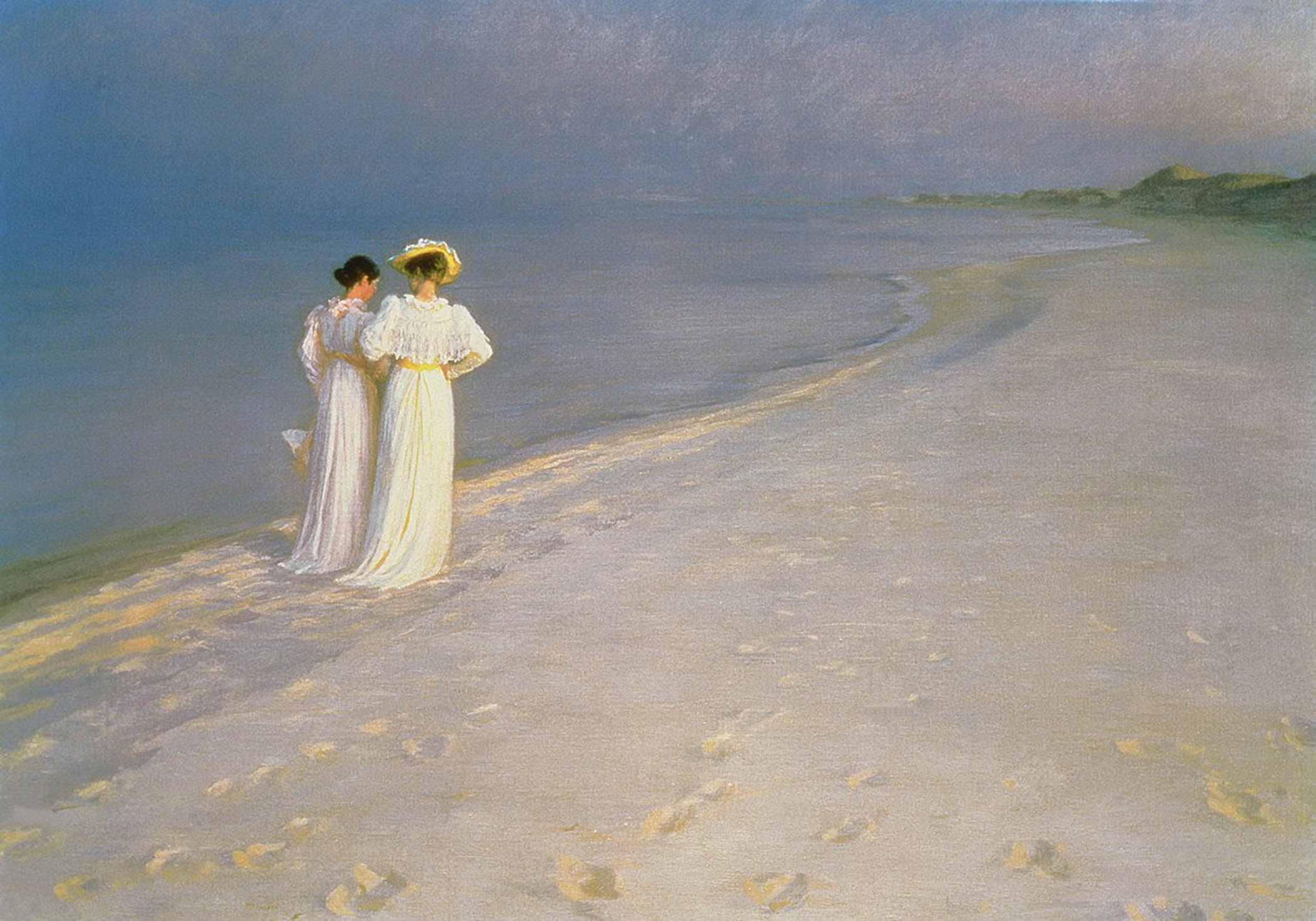
Peder Severin Krøyer’s Summer Evening on Skagen's Southern Beach depicts his wife Marie talking to Anna Ancher. Main image: Ancher’s The Harvesters from 1905
If you had to name a single female painter who actually thrived during her own lifetime, then Ancher (1859-1935) may be the one. She finds fame at the start and never loses it, despite marrying a fellow painter and raising their daughter, Helga. Where other 19th-century women discovered there was no room for two painters in a marriage, she lived so companionably with her husband, the Danish painter Michael Ancher (1849-1927), that his silver wedding gift to her is a double portrait in which he looks at her with enduring love (she, of course, looks modestly away). There is no down period.
Anna Ancher was the only member of the Skagen painters’ colony to be born and brought up in Skagen. Her parents, Erik and Ane Brøndum, owned the village inn. The night Hans Christian Andersen came to stay in the summer of 1859, lured, he wrote, by the roaring seas and the music of wild geese over the shifting dunes, Ane gave birth to Anna, the fifth of six children. Three daughters and one son worked all their lives in the inn. Ancher’s 1917 painting After the Day’s Labours shows two of her sisters, eyes shut in weariness, one of them head down on the polished table, exhausted in a twilit blue room.
The inn began to flourish with the arrival of more writers and artists from the 1870s onwards. It was extremely hard to reach, involving slow trains to Frederikshavn followed by a 25-mile journey in horse-drawn carts along the sands. When the Danish poet and painter Holger Drachmann first arrived in 1872, it took four days to slog there. Some brave souls hiked the last stretch. One of many sunlit portraits of Krøyer shows him cresting the dunes in walking boots.
These painters stayed at the inn, which flourished into what would become – and remains – the renowned Brøndums hotel. The teenage Ancher saw their canvases drying in the whitewashed bedrooms while the artists were out on the beach at their easels. She began to draw. And one day in 1874, according to a letter, Michael Ancher happened by. He is “not of the worst looking”, she wrote, with true Skagen understatement.
Anna Ancher began to paint in oils, encouraged by her mother, who sent her to study for three winters at a private art school in Copenhagen. Women were not admitted to the Royal Danish Academy of Fine Arts on equal terms with men until 1924. It is telling that most of the figures in Ancher’s art are women, including the girl in her earliest masterpiece, The Maid in the Kitchen, from 1883-86, which will be on show in Dulwich.
Yellow-gold light dances through a fine muslin curtain across the window, illuminating the surfaces, glowing against walls, pooling on the wooden floor. The eponymous maid stands at the sink, a dark backlit form. Her skirt is a rich thrumming red, balancing the gold and the darkness below. Loving its sense of order and absorption, the Danish magnate Heinrich Hirschsprung bought the painting on sight. It is now housed in the neoclassical Hirschsprung Collection in Copenhagen.
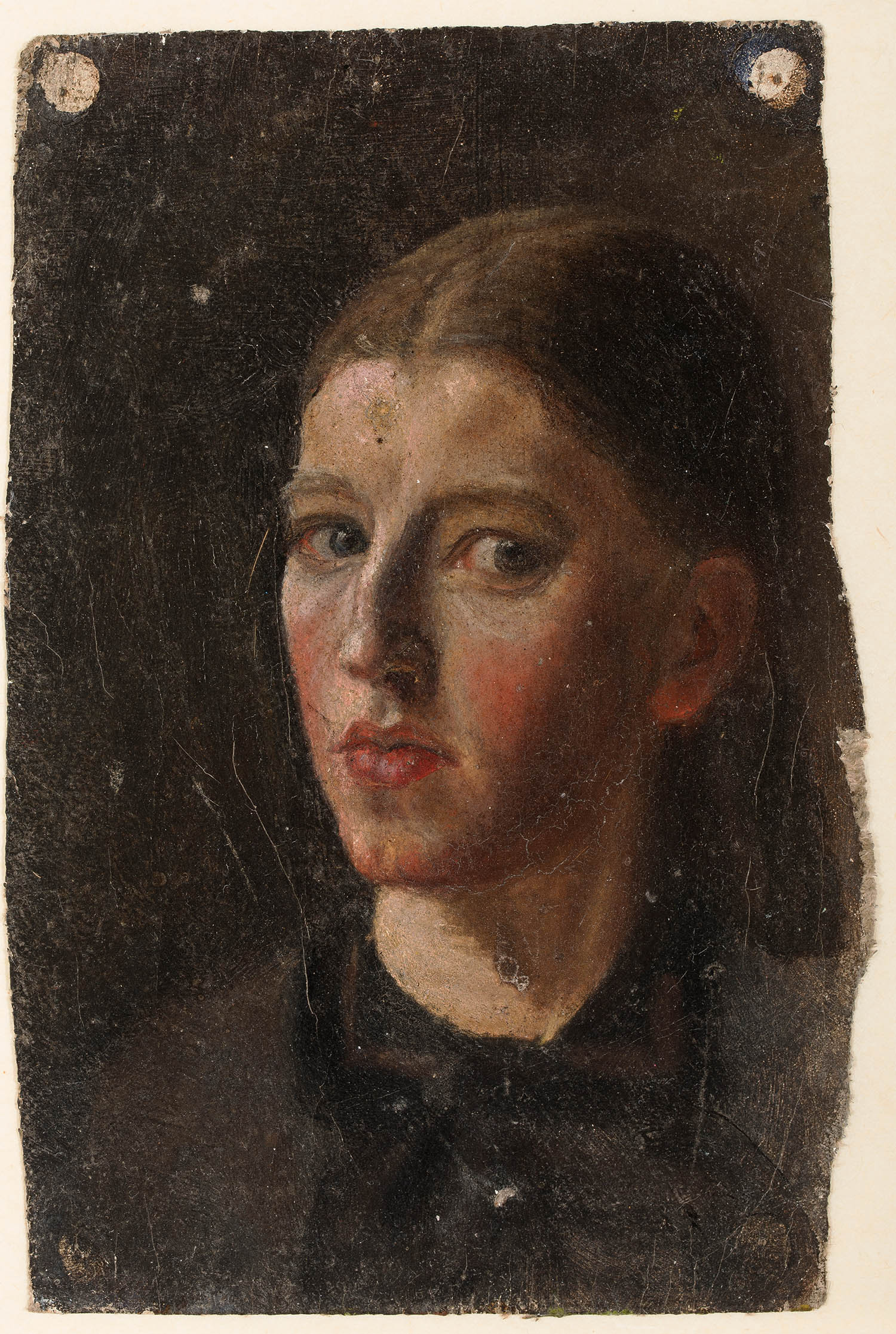
Ancher’s only self-portrait, from 1879
AB became AA when she married Michael Ancher on her 21st birthday. Even on a chilly Jutland day, the ochre and umber church burns like an Edward Hopper street scene, raked with American sun. The houses of Skagen are the colour of honey and butter. Look through the windows and you see glowing interiors, often lit by candles even now. Many of Anna Ancher’s paintings are set in the blue or red rooms of the Brøndums, where she first lived, and to which she returned from the marital home next door almost every day.
The Brøndums hotel is still the heart of Skagen. It would be hard to imagine a more lucid interior. The public rooms are boxes of light, opening one into the next, where guests sit at candlelit tables among paintings that were made in this building long ago, beneath elegant high windows. I ate Madame Brøndum’s famous fish soup at a white-clothed table beneath a portrait of Ancher and her sisters, by now silver-haired, facing forwards in neat profile. They are almost identical, except for Ancher’s nose.
Skagen’s population of less than 8,000 swells by more than two million over the course of the summer. Wealthy Copenhageners visit to take the sun and sea air. Skagens Museum is dense with worshipful crowds, coming for the Drachmanns, Anchers and Krøyers. The Brøndums hotel is booked out, staff sweeping the sand away down long wooden corridors and serving their own eggs and cured salmon at breakfast. There is no television, no canned music. Karen Blixen wrote much of Out of Africa here as a long-term guest, and writers are still so attracted by its immaculate stillness that one comes annually with his own fridge so that he barely has to stir from his room. Emil Hauge, the hotel’s excellent manager, takes great care of his guests. “We do not march about in winter,” he tells me, “after the visitors in shorts have gone. It is silent time, for reading, for thinking.”
Nowadays, flights dart in and out of Aalborg airport from all over the world, followed by a train journey of austere beauty across the flatlands to Skagen. You can walk to the shore in moments from its orderly streets, or cycle out across the landscape to the famous Sand-Buried church, all but its stepped white tower lost to the dunes. The shores are dotted with rivals for the enchanting hotel in Channel 4’s long-running period drama Seaside Hotel – Badehotellet in Danish – a snapshot of Jutland between the wars, before the Germans occupied Denmark.
At the Brøndums hotel, the Nazis used the Green Room for secret operations and the Blue Room for daily gymnastics. The sacrilege will be evident to anyone who looks at Ancher’s many paintings of her mother, Ane, reading the Bible, resting after her labours and finally dying, at the age of 91, in the Blue Room.

The Maid in the Kitchen will be on show in the London exhibition
Some visitors still like to take the red Sandormen bus (which has scarcely evolved since its open-top days) along the shore to the point at Grenen. But it is a perfect walk along compact white sands, windmills and lighthouses piercing the skyline. Even now, as the temperatures begin to fall, and the bus ceases for winter, the clouds are tinged cobalt, green and coral, and the sunset is pure fiery orange as if it were still high summer.
Ospreys and sea eagles can sometimes be seen wheeling through the sky. Grey seals lounge along the shore. The sea runs all the way through palest opal to a colour I have never seen anywhere else, an electric blue that runs in icy beams across the waves. Hanne Aavang of Skagens Museum lived here for decades before a marine physicist explained this mystifying spectacle. “It is the result of a constant interplay between the reflections of these two separate seas in the sky, and back again, for ever. The light never stops fluctuating at Skagen.”
All the male artists were out on the beach, painting the water, painting one another. But not Anna Ancher. She stays inside, always painting the light, to be sure, but within the interiors of the Brøndums hotel, and then in Anchers Hus, where she lived with Michael, and in other rooms in Skagen. The whole village became her studio.
The light never stops shifting, glowing, flickering through the windows in her art. Occasionally, you see open fields, faraway houses or a twist of cloud through the panes, but mostly they are portals of light. A seamstress stares down at her work, six amber rectangles transmitted through an invisible window on to the wall behind her. In a red-on-red study of the elderly Ane, the gentleness of the light equates with the fading of life. There are seascapes of moon on water in this show, and of Skageners getting in the harvest in hot summer landscapes, but they look like the work of other painters.
What is so unique about Ancher is that the light arriving through windows, screening across walls, or reflecting through interiors in her work always attracts the greatest impasto: the thickest of brushstrokes for the most ephemeral of effects. Some of the paintings are unframed, made on thrifty rectangles of hessian tacked straight to the wooden stretcher, not even folding round the back. They are frail. Tor Erik Skaaland, conservator at Skagens Museum, shows me an ingenious clear resin panel inserted behind one painting to add strength. It looks like a little window in its own right.
He says that colleagues are analysing a famous double portrait of Michael and Anna Ancher staring at the day’s labours, on an easel, to see if they can work out which artist painted what. It is not an idle pursuit, this distinguishing of Anna from Michael. His work is more finished, schooled, conventional: fishermen, beach scenes, the terrors of the turbulent seas, his wife and his many painter friends. But Anna is harder to pin down – wilder, travelling in too many different directions. Dulwich Picture Gallery has chosen carefully, singling out her most individual routes.
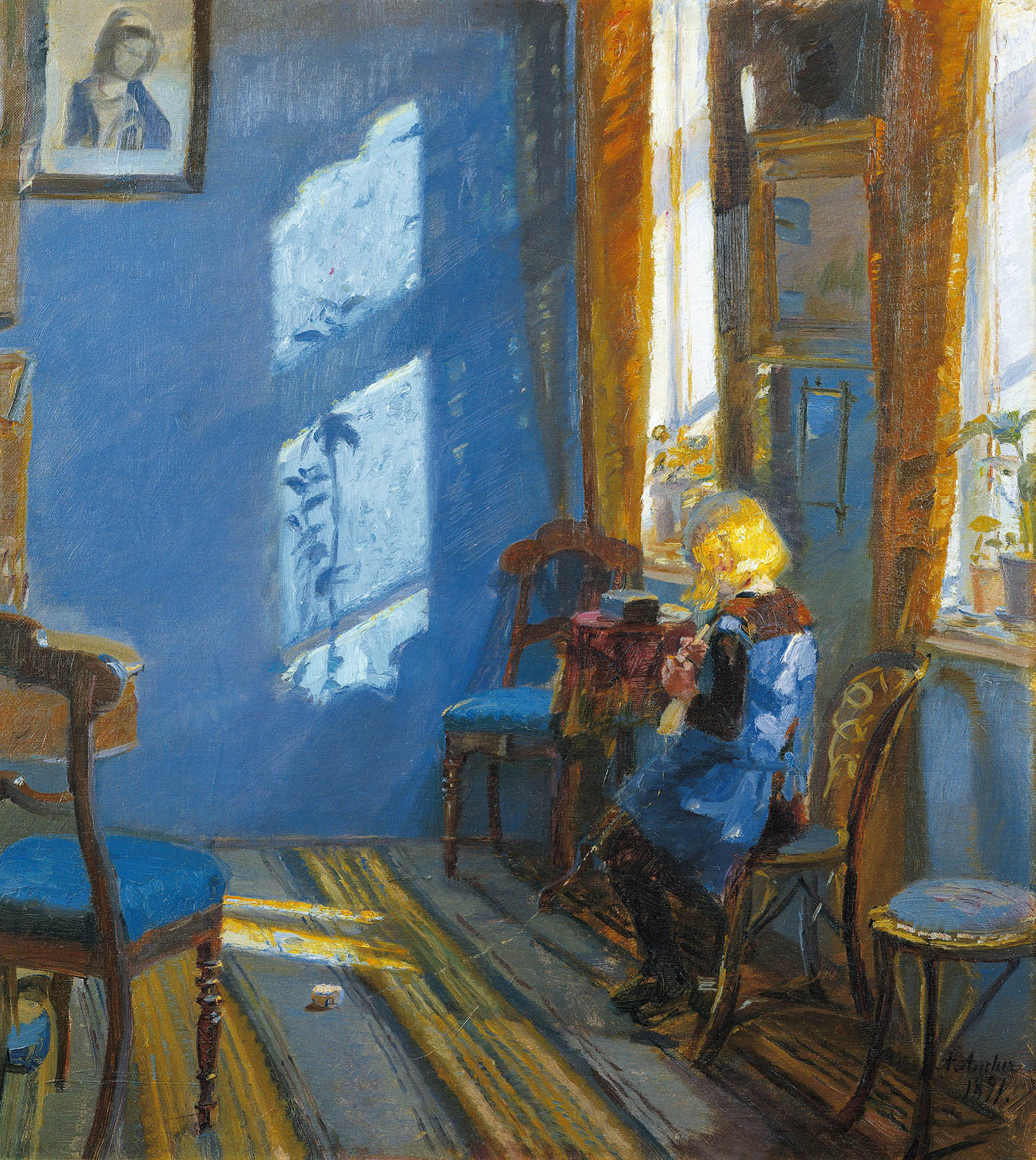
Ancher’s painting Sunlight in the Blue Room, from 1891
Skagens Museum has in its collection nearly 5,000 photographs of the artists’ colony and numerous paintings of painters conversing, carousing or playing cards in the dining room at Brøndums. This is where they went when the light had gone: the only hostelry for miles around where they could get fine food and French wine. Eavesdropping on a Danish visitor at the museum, staring at a dinner scene where all the men are raising a hearty glass over a bottle-strewn table, I heard her name every artist in the picture, from Laurits Tuxen with his terrific head of hair to Drachmann with his twisting moustache, and Michael Ancher, blue-eyed and pale-bearded. But the figure she most readily identified was Anna Ancher, on the edge of events, ever-upright in her striking quietude.
The dining room at Brøndums appears over and again. Painters sometimes paid their bills with hotel scenes. There are dining room paintings inside dining room paintings. The Skagen artists painted portraits of one another to be inserted into a frieze running right round the room from the 1890s onwards. Artists appear against marine skies or Brøndums candlelight; they paint themselves laughing or furiously smoking, especially in the case of one woman marking her independence from the Skagen patriarchy (Danish women didn’t get to vote until 1918).
Larger paintings of the waves at Grenen, say, or of card players dragging on pensive fags, were set into the wood panelling below the 81 heads that run around the top. It was in this very room that the decision was made, in 1908, to start a collection in the hotel grounds that would eventually become Skagens Museum. And it is in that very museum that the entire dining room – wood panelling, windows, paintings, doors and all – can now be seen, meticulously taken apart and reconstructed here as a living installation after the second world war.
At the centre of all these portrait heads, as if he were still running the hotel, is Ancher’s brother Degn Brøndum. Cigar between lips, he twinkles from the only circular portrait. Ancher appears two along, painted by Krøyer, face hidden inside a straw bonnet, elusive in this pageant of garrulity.
Krøyer was quick: he could achieve a portrait in 20 minutes. Ancher was not. Someone once described her studio as the most private room in Skagen. To reach it, you wend your way through the smaller rooms of Anchers Hus, floor to ceiling with pictures, until the rooms grow bigger with the couple’s increasing prosperity, culminating in Michael Ancher’s enormous triple-aspect studio. Through a door at the very end is Anna Ancher’s little room, pale blue curtains against flickering sunlight, the easel exactly where it always stood, her many brushes still in their pots, a low table, just right for a child.
You can see a corner of this room at Dulwich Picture Gallery. Evening sun, filtering through those curtains, sends pink-gold rays against the wall. Muted shadows shift below. There is no narrative, no tale of lost fishermen or convivial dinners, rapt seamstresses or old women reading the Bible, no figures at all. Ancher is in her element: pure light. Two canvases stand on the floor, faces turned discreetly to the wall.
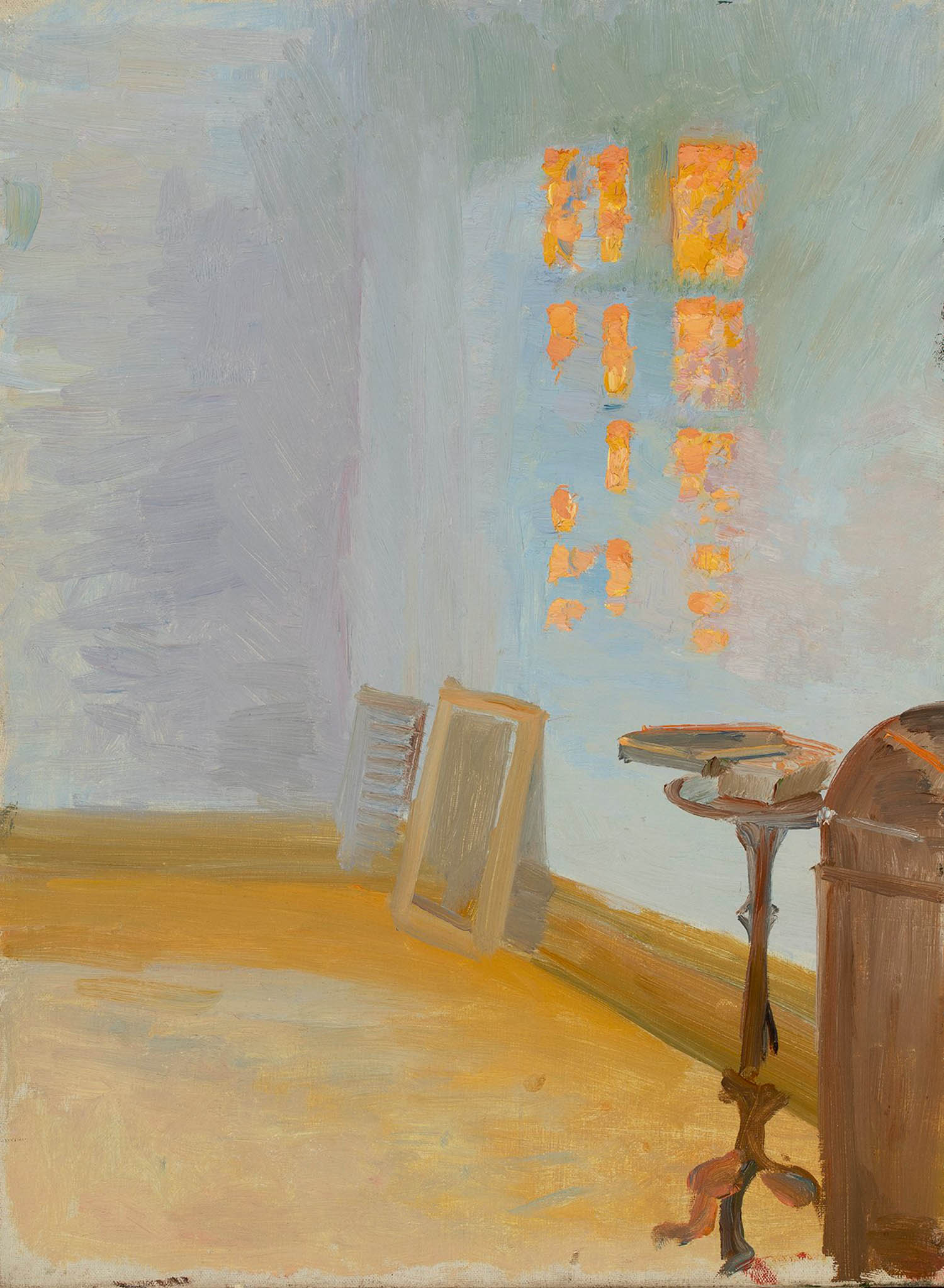
Evening Sun in the Artist’s Studio was not painted for public display but is now among Ancher’s most prized works
The Danish state bought Ancher’s large painting A Funeral, its mourners crowding into a low-ceilinged cottage, when she was barely 30. The Maid in the Kitchen came to London. She studied for six months with the French symbolist Pierre Puvis de Chavannes in Paris, and the Anchers’ popularity bought them a house in Copenhagen. But none of this public success is reflected in her art and she left no paintings of the world beyond Skagen, specifically the tiny enclave of her home and the family hotel.
Evening Sun in the Artist’s Studio, as it is now titled, had neither name nor date. It is what used to be called an oil sketch, not made for public display. Ancher kept all such paintings out of sight, secreted away in cupboards and drawers. They are now the most prized of her works.
As winter comes on, the waves get higher. The sea at twilight is a fiery silver and crosswinds plough the dunes. When I say that the shore never changes, from those paintings to this day, Hanne Aavang at the museum points out that this is entirely untrue. More than a million cubic metres of sand shift along the coastline to Grenen every year. Nothing is quite as it was.
A house on the beach, terrifyingly close to the sea, is beginning to silt up with sand. I cycle to the Sand-Buried church, miles inland, where all that remains is the white stairway of its tower. Krøyer, so flamboyant and merry, suffers a devastating breakdown and loses his wife to another man, dying at the age of 58. Michael Ancher dies in 1927, leaving Anna a widow in her sixties. When Drachmann dies in the bitter winter of 1908, after three doomed marriages and a lifetime of betrayals, he is buried in the dunes at Grenen.
Anna Ancher lives on, steadily painting until the spring of 1935. By then, the branch line to Skagen has been running for decades, the first cinema has already opened and closed, and vacuum cleaners have arrived at the Brøndums hotel. She continues to believe that her luminous little paintings, on show at Dulwich, are so insignificant they will only be discovered long after her death. Cut off from the world on this narrow peninsula, her life encompassed in less than a mile, she goes on painting while the rest of the art world is convulsed by fauvism, cubism, surrealism, abstraction. Modern art rages onwards, but it seems Ancher does not realise that the very paintings she views as nothing more than empty sketches, to be hidden away, will one day be regarded as her masterpieces.
Anna Ancher: Painting Light is at Dulwich Picture from 4 November until 8 March 2026. Laura Cumming travelled as a guest of VisitDenmark and Destination Nord
Images courtesy of Skagens Museum, courtesy of Dulwich Picture Gallery, courtesy of Laura Cumming
